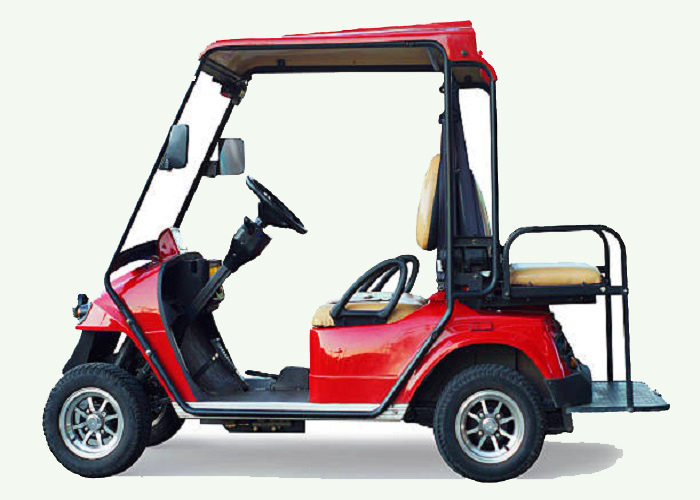
You would first believe that the answer to the issue of how many wheels a golf cart has is very straightforward. But wait, let’s delve a little further. This specific subject has a startling complexity and diversity to it. The typical golf cart? Yes, usually, it rolls on four wheels. However, the golf cart industry is active and diversified, with many designs and features that might affect the number of spins. Now, let’s begin this intriguing investigation of golf carts, including their techniques, applications, and enthralling range of variants.
The Commonplace 4-wheeled Golf Cart
Well, let’s begin with the fundamentals. In golf carts, the four-wheel drive model is the mainstay. It comes to mind when you imagine spending a relaxed day on the golf course. These golf carts are the pinnacle of golf cart design, speeding along the fairways. Four wheels: two up front for quick handling and two behind for a solid, balanced ride. For a good reason, it’s the traditional configuration.
Why Choose Four Wheels?
Why four wheels? It all comes down to finding the ideal balance between manageable and solid enough not to throw you off balance, particularly when you’re speeding around a curve and your golf clubs clattering behind you. Remember that it’s all about gliding on the field with ease. Nobody likes to see their morning cup of coffee spill as they race to the next hole.
The Six Wheelers:
Then, just when you thought you understood everything, along come the six-wheel variations. These golf carts aren’t your typical ones; they’re the robust, ‘come it on’ kind. More extensive golf courses and certain situations involving heavy lifting are where you may locate them. Extra wheels? Increased capacity to support a heavier load and increased stability.
The Advantage of Six Wheels:
Why not add six wheels to boost the ante? It all requires additional stability and strength to lift heavier loads. Imagine towing a whole load of equipment with a standard four-wheeler for maintaining golf courses. You may even risk a tip-over if you are in a tight place. Six wheels distribute the weight more equally, improving stability and grip. This is especially useful on courses with undulating terrain or on slick surfaces.
The Golf Carts with Three Wheels:
Let’s now focus on a little less typical: the three-wheeled golf cart. These were quite popular in the past. Picture a tricycle with two wheels supporting the front wheel and one wheel leading the charge. Relatively small and eccentric but less stable than the four-wheel models.
The Three-Wheel Compromise:
What caused the three-wheelers to disappear from view gradually? The critical issue is stability. They tipped quickly, especially when negotiating rough terrain or taking corners with too much vigor. Golfers and course administrators promptly realized that four wheels are better than three regarding stability and safety.
10 vs. 12 golf cart wheels:
A golf cart can be a versatile and fun vehicle for transport on the course. One of the most common upgrades to a golf cart is switching out the stock wheels for larger ones, typically 10″ or 12″ in diameter.
But which size is better? Is there much of a difference between the two?
The answer depends on your personal preferences and needs. The following elements should be taken into account when choosing between 10″ and 12″ golf cart wheels:
-
Maneuverability
The agility of the course’s 10″ and 12″ golf cart wheels is one of their primary distinctions. Smaller, 10″ wheels are more agile and can make tighter turns, while larger, 12″ wheels have a wider turning radius. If you frequently navigate through narrow paths or tight corners on the course, 10″ wheels may be your better choice.
-
Ride Comfort
Another factor to consider is the overall ride comfort of the golf cart. More significantly, 12″ wheels have more surface area in contact with the ground, which can provide a smoother and more stable ride. On the other hand, 10″ wheels may be more bumpy and unstable on rough terrain. If you prioritize a comfortable ride, 12″ wheels may be the way to go.
-
Ground Clearance
The size of your golf cart’s wheels can also affect its ground clearance. Larger wheels will generally have a higher ground clearance than smaller ones. This can be beneficial if you frequently drive over rough or uneven terrain on the course. However, it’s important to note that some studies restrict ground clearance for golf carts, so check with your local system before deciding.
-
Aesthetics
Consider the visual impact of 10″ and 12″ wheels. Smaller wheels may have a more conventional or classic look, while larger wheels can lend your cart an aggressive and dynamic appearance. Additionally, take into account the available color and design options for each wheel size, as they can greatly influence your cart’s overall aesthetics.
-
Cost
Price naturally plays a crucial role when it comes to upgrading your golf cart’s wheels. Typically, 12″ wheels tend to be pricier than their 10″ counterparts due to their larger size and increased surface area. However, keep in mind that factors like specific features and brand reputation can also influence the price differential. Therefore, before deciding between the two sizes, it’s essential to carefully consider your budget
8 vs 10 golf cart wheels:
Which one do you want? Now that we’ve discussed the changes between 10″ and 12″ golf cart wheels, you may be interested in even smaller sizes, like 8″. There are these choices. Still, they are less popular. They may not offer as many benefits as the larger sizes. fortunately if maneuverability is your top priority, 8″ wheels may be a good choice for you.
Ultimately, the best size of golf cart wheel for you will depend on your preferences and needs. Consider maneuverability, ride comfort, ground clearance, aesthetics, and cost when deciding. Whichever size you choose, upgrading your golf cart’s wheels can significantly improve its performance and appearance on the course.
Gas vs. Electric Power:
When one stands at the crossroads of the gas-versus-electric power problem, a decision teeming with far-reaching implications and multifarious considerations, it becomes imperative to navigate the labyrinthine corridors of advantages and drawbacks that each option unfurls before us. What appears to be a deceptively straightforward choice, upon closer inspection, reveals itself as an intricate tapestry interwoven with a plethora of factors.
Gas power, a venerable choice deeply entrenched in the annals of vehicular history, beckons with its visceral connection to the combustion engine, offering a symphony of familiar roars and the promise of robust torque. Yet, it carries with it the heavy baggage of emissions, a weighty contributor to the planet’s burgeoning environmental woes, thereby igniting fervent debates about its long-term sustainability in an era witnessing a surge in eco-consciousness.
In stark contrast, the siren song of electric power serenades us with its promise of a cleaner, greener tomorrow. It lures us with the seductive silence of its operation and the irresistible allure of a reduced carbon footprint. However, lurking beneath its seemingly pristine surface lies the specter of range anxiety, a gnawing fear that our journey may be curtailed prematurely. Moreover, the landscape of charging infrastructure, though expanding, remains a patchwork quilt of accessibility. And let us remember the labyrinthine complexities of battery disposal, a problem that haunts the corridors of our environmental aspirations.
The Scene of the Electric Golf Cart:
Electric golf carts are preferred by those who care about the environment. They are clean (no fumes!), silent, and ultimately more cost-effective. They work particularly well on golf courses because of their shorter lengths.
Gasoline Powered Golf Carts:
Conversely, gas-powered golf carts can cover greater distances and provide more power. More extensive golf courses or situations requiring the movement of a higher weight are suitable for them. The cost in kind? They’re not nearly as kind to the environment and are noisier.
Golf Cart Design:
Golf cart design and development is a story of accommodating players’ and course management requirements and preferences. Every design has a use and a place, from the first three-wheelers to the mostly four-wheeled vehicles of today and the sporadic emergence of six-wheelers. It demonstrates how invention shapes our toys and equipment.
Peering Into the Future:
What role will golf carts play in the future? We could see a change to more environmentally friendly vehicles, cutting-edge safety measures, and perhaps even the introduction of autonomous golf carts.
Conclusion:
Choosing the right wheels for your golf cart is a decision that can greatly impact your experience on the green. There’s a lot to think about when it comes to this seemingly small detail, but rest assured, it’s an important one. Your choice of wheels can affect everything from how smoothly you navigate the course to the way your cart looks. Let’s dive into the factors to consider when upgrading your golf cart’s wheels.
FAQs
What is the standard golf cart wheel pattern?
The standard wheel configuration for golf carts typically consists of four wheels, with the front two being smaller than the rear two. However, there are alternative options available, allowing for different numbers and configurations of rotations to match your preferences and requirements.
Can I upgrade my golf cart’s wheels?
Yes, you can upgrade your golf cart’s wheels to improve its performance and add style to your game. Consider factors like size, maneuverability, ride comfort, ground clearance, aesthetics, and cost before deciding.
What is a standard golf cart?
Navigating the course with ease is crucial for every golfer, and the choice of wheels plays a pivotal role in this aspect. Typically equipped with four wheels and powered by either gas or electricity, these upgrades can significantly enhance your experience. To select the ideal pair of wheels, it’s essential to consider various factors.
What is the standard-size golf cart tire?
The standard size for golf cart tires is 18×8.5-8 inches, although different sizes and styles are available depending on your preferences and needs. However, checking with your specific golf cart model to ensure compatibility before purchasing is essential.
What is the most common wheel pattern?
The most common wheel pattern for golf carts is four wheels, with the front two more minor than the back two. It’s essential to confirm with your particular golf cart before assuming the conventional sequence, though, as specific models can have a different number or arrangement of spins. Ultimately, your demands and tastes as a golfer will determine which wheel layout is ideal for you. Decide which choice best suits your needs after weighing all of your possibilities.




